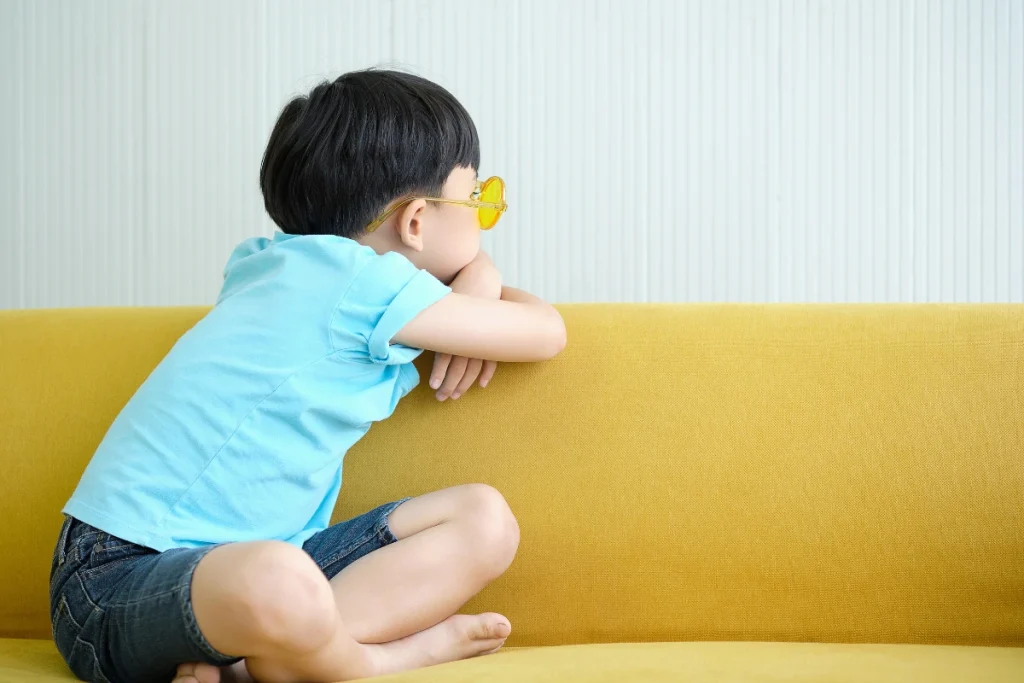Fixated behaviors, also known as perseverative behaviors or autism stimming, are common in neurodivergent individuals. Sometimes they can interfere with daily functioning and for others, they provide a sense of comfort and predictability.
I have seen many diverse types of fixations in my years working with neurodivergent children, some that help and others that are harmful. They have ranged from finger tapping and hand flapping to head banging and eye gouging and everything in between.
In my experience, the place to start is understanding what fixations are, what they may look like, whether they are helpful or harmful and how to manage them.
Examples of Fixations
Fixated behaviors in the neurodivergent community can manifest themselves in a variety of ways and can vary widely from individual to individual. Below are some that are commonly seen but is in no way an exhaustive list.

1. Obsessive Interest in Certain Objects or Topics
The child may become fixated on a particular toy, game, or topic of interest, and may spend an excessive amount of time engaging with it.
For example:
- A fascination with trains or planes and all the finer details that go with them, including the names and numbers, diverse and distinct types, how they are built, how they run, their schedules, and the routes they take.
- An intense interest in a particular movie or TV show, such as watching the same episode repeatedly or reciting lines from the show over and over. They may have a favorite character that they become obsessed with, or it could be the show in its entirety.
- A preoccupation with a particular video game. This includes more than just wanting to play it, but dissecting the plots, levels, characters, music, and every detail needed in advancing in and needing to win the game.
- A fixation on a specific topic, such as dinosaurs, insects, weather patterns, maps and geography, outer space and astronomy or insects, to the exclusion of all other topics.
- An obsession with a particular toy or object, such as balls of assorted sizes and textures, bouncy or squishy. Action figures including those from movies. Cars, trucks, and other vehicles including model cars and remote-controlled cars. Electronic devices such as tablets or phones with specific apps. Stuffed animals and soft toys which also might extend to blankets and teddy bears.
- An interest in collecting or categorizing objects, such as rocks, seashells, or action figures. They would spend a significant amount of time gathering and arranging these objects and displaying them in a specific order or pattern. If the collection is disrupted or moved, they can become very upset to the point of meltdown if things are not returned to their original position. They may continuously talk at length about the collection in great detail with excitement and enthusiasm. The collection is never complete as they continuously search for more items to add to it.
- A fascination with music. This may include playing the same song over and over or being able to identify individual instruments or sections of music. They might memorize lyrics to songs and sing them repeatedly. They may have a fixation on a particular instrument, artist, or a genre of music.
- An obsession with numbers or patterns. They may be able to pick out patterns in things that a neurotypical person couldn’t, they might write certain numbers repeatedly, or recite multiplication tables. They may have an incredible memory for numbers, being able to recite pi to many digits or remember bank accounts or phone numbers without effort. They may have a deep interest in patterns or sequences, such as the Fibonacci sequence or prime numbers.
2. Repetitive Behaviors

A child with autism may display repetitive behaviors such as finger-flicking, hand flapping or other hand movements. They might rock back and forth or bang their head on the floor.
They might spin around repeatedly or rotate objects over and over. They could repeat movements such as tapping or turning lights on and off, or the TV volume up and down.
Other repetitive behaviors may include repeating sounds, words, or phrases which is also known as echolalia.
They may engage in ritualistic behaviors, such as always entering a room in a certain way or following a specific sequence of steps before performing a task.
Many times, these repetitive behaviors bring a sense of comfort and is a way of self-stimulating the vestibular system. If they are not interfering with others, or daily functioning for themselves, they are harmless. Obvious exceptions would be when the behavior may bring harm to themselves or others.
3. Strict Routines
The child may insist on following strict routines or schedules and may become upset or anxious if their routine is disrupted. for example, a child may have a meltdown if a parent does not take the exact same route to school each day. This can be to the point of having to retrace steps and start from the beginning.
A child might follow specific rituals or patterns for completing tasks, such as putting on clothes or brushing teeth and have a strong need for predictability and sameness in their daily life.
They might insist on having the same meal at each mealtime, eating a very narrow range of food and even having the same food up to three times a day.
4. Fixated on Specific People
Children with autism can sometimes become fixated on a particular person. This may be a family member, a teacher or someone they have an ongoing association with. They may seek to constantly interact with that person and display behaviors with the intent to gain attention from them.
They might memorize details about the person such as birthdays, their favorite color or food. A deep emotional attachment may form and being around the person might bring a sense of peace and comfort, helping to calm anxiety.
The child might also begin mimicking the person’s behaviors, such as speaking like them or imitating their mannerisms.

5. Preoccupation with Parts of Objects
Fixation on a specific part of an object might include spinning the wheels of a toy car or lining up objects based on color or size. A child might have a keen fascination with the buttons on a remote, the texture of objects and may constantly stroke them or lick them, even if it is something like the bottom of a shoe.
These preoccupations do not include the whole item but are limited to parts of it.
6. Sensory Fixations
These types of fixations involve the senses and could be anything from consistently touching a silky fabric to staring at lights. A child with a sensory perseverative behavior may be obsessed with the taste of a certain food, or a certain smell. They may smell food intently before eating it or may even smell it and then refuse to eat it depending on the information received through smell.
They might focus on certain sounds or noises, such as the hum of a fan or the sound of running water.
They could be extremely sensitive to certain lights, the color of a lipstick or certain sounds. In contrast, it could work the other way with them being obsessed with the same things.
When are Fixated Behaviors for Those with Autism Harmful?
It’s important to note that not all fixated behaviors are harmful, and that some may even have positive benefits for the child’s development and well-being. However, if fixated behaviors are interfering with the child’s ability to participate in daily activities or interact with others, or learn new skills, it may be necessary to seek professional help or implement strategies to reduce the behavior.

Some examples of harmful fixated behaviors may include:
Self-Injurious Behavior
This is when an individual fixates on certain objects or activities to the point of self-injury. Examples of this might be things like:
- Headbanging: Repeatedly hitting one’s head against a solid surface, such as a wall or the floor. This is a difficult behavior to stop when they want to keep repeating it, but severity of injury can occur from a bleeding forehead to skull fractures and brain trauma.
- Biting oneself: This is not just gently biting or chewing on the arm but biting anywhere on the body where they break the skin and cause bleeding or bruising.
- Pulling one’s hair: Pulling one’s hair out, either in lesser amounts or in large clumps, causing bald spots or damage to the hair follicles. This is not only painful but if done over an extended period can stop hair from growing back.
- Scratching oneself: Scratching one’s skin with one’s fingernails or other objects, causing redness, bleeding, or scarring. Apart from the actual injury, there is also the risk of infection or tetanus from dirty objects being used.
- Eye poking or eye gouging: Repeatedly poking or gouging one’s own eyes, causing injury or even blindness. It doesn’t take much to cause blindness whether temporary or permanent so children with this fixation need to be closely monitored.
- Pinching: This is when a child pinches their own skin with their fingernails or other objects so forcefully that it causes pain or bruising.
- Hitting: A child with autism will sometimes hit themselves over and over with their fists or other objects. This can cause pain or damage.
Disruptive Behavior
Disruptive behaviors are not always present in children with autism. If they do appear, disruptive behaviors are part of a fixated behavior, but all perseverative behaviors are not disruptive.
When behavior becomes disruptive, it impedes a child’s ability to participate in group activities or learning opportunities, further compounding already existing social challenges.
These types of behaviors may include:
- Complete refusal to participate in an activity that does not coincide with their intense interest. This can cause issues at home but particularly in a school environment which can quickly turn to meltdowns if strongly encouraged to participate.
- Engaging in obsessive behaviors that may not normally be disruptive but doing it loudly (such as vocalizations) or close to people’s faces (eg flapping hands). Another example would be pacing up and down in a classroom, which could also be disruptive to students trying to concentrate.
- Insisting on talking excessively about their fixated interest in a setting that is not appropriate or socially acceptable.
- Becoming aggressive towards others who may be interfering with their ability to participate in the behavior, or they may see them as disrupting the pattern of behavior in some way. For example, someone walking across the path where they want to pace back and forth.
- Engaging in self-injurious behavior if they are interrupted or attempts are made to stop them participating in or completing the behavior.
Restricted Interests
It is not unusual for a child with autism to experience restricted interests because of having fixated tendencies. While this can sometimes provide comfort and enjoyment, it can also create issues in a lack of knowledge and skills across a broader range of topics.
Some examples of issues that can arise from restricted interests are:

Social Isolation
Social isolation can easily happen with challenged social skills already occurring. If a child’s focus and attention is totally restricted to one or two topics, they can neglect the social interactions they do have which can lead to social isolation and difficulties in making friends.
For example, someone who is fixated on trains might spend all their time researching train schedules, types and names of trains, routes they take and become upset or anxious if they are unable to engage in the way they desire with the interest. This can make having conversations that do not involve trains extremely difficult. This can negatively impact on social skills and building relationships and friendships with peers.
Social isolation can negatively affect mental health and well-being. For individuals with autism, they need more opportunities and practice with social engagements and interactions with others, even if they do not share the same interests.
Social isolation can have negative consequences on an individual’s mental health and well-being, and it is important for individuals with autism to have opportunities to engage in social interactions with others, even if they do not share the same interests. Support and intervention may be necessary to help them interact and avoid social isolation.
Difficulty Transitioning
The inability to transition easily is commonly an issue with neurodivergent individuals but when they have fixated behaviors or interests, it is twice as difficult.
They may become so engrossed in their repetitive actions that they have a challenge in shifting their attention or transitioning to a different activity. This can lead to becoming anxious or meltdowns and can interfere with daily living such as getting dressed, eating, getting ready for school etc.
For example, a child with autism who is fixated on playing video games may have a difficult time stopping their game to eat dinner or do homework. They may become upset or have a meltdown when asked to transition to a new activity, which can disrupt daily routines and cause stress for both the individual with autism and their caregivers.
Inflexibility
Being inflexible is another common challenge for individuals with autism but can be made more challenging with fixated behavior. This comes from anxiety and stress when having to move from one activity to another.
This inflexibility can also impede the ability to problem solve as they can struggle to find creative solutions to problems because their inflexibility and narrowed focus leads to a limited range of approaches to a given situation.

When is Fixated Behavior with a Child with Autism not Harmful?
In the same way these fixated behaviors can be harmful, they can also have positive effects. In some cases, the repeated actions have positive benefits on the child’s development and well-being.
Here are some examples of when fixated behavior may be positive:
Positive Effects on Mental Health
These repetitive actions can have a calming effect and even reduce anxiety and stress. This can be extremely helpful in social situations, meeting new people, at school or home, and can bring calm to prevent a meltdown. They can even be a sign to a parent or caregiver that the child is feeling stressed and so engages in fixated behaviors. In children who struggle to express their feelings, this can be a good non-verbal cue.
Encouraging Creativity and Imagination
Fixating on certain topics or objects may lead to increased creativity and imagination and may even inspire the child to pursue a particular interest or hobby.
Building Knowledge and Expertise
If a particular topic is the fixated behavior, it can lead to an in-depth knowledge and even expertise in that area. I have seen children with advanced knowledge on maps and geography, trains and dinosaurs. Having and expressing this knowledge can be a source of pride and accomplishment for the child.
Providing Predictability
Perseverative behaviors can also provide predictability for a child with autism which, in turn, provides stability and emotional security. Neurodivergent individuals crave predictability because the ability to be flexible and adapt to change is so challenging. This produces a feeling of having more control over their environment which can reduce anxiety.
How to Deal with Fixation in Autism
Fixations can be really frustrating to deal with, particularly if they are disrupting others or worse, causing harm to the child. The aim is to reduce the intensity and frequency of fixations.
Here are five tips for dealing with fixation in autism
1. Identify Triggers
Identifying triggers can be problematic but when found, trying to limit exposure will hopefully reduce the intensity or occurrences of fixations.
Keeping a journal is a fantastic way to establish patterns and things that may be problematic. Note the behavior, the time of day, location, and any other relevant information.
Observe the Individual
Valuable information can be gleaned from observing a child and their fixated behaviors. By carefully observing the behavior, environment, and body language, caregivers and professionals can gain insight into potential causes. Also look for environmental factors, such as sounds, smells, or visual stimuli, which might be contributing to the behavior.
For example: is the child rocking more intensely during certain times of day or in certain environments? Is there a particular sound or visual stimulus that is triggering the behavior? Remember that often sensory input can be a challenge to individuals with autism and the inability to process sensory stimuli effectively can lead to it being a trigger.
It can also be helpful to observe their behavior during more neutral or positive times. This can provide a baseline for comparison and may expose additional information that can help identify changes in behavior that may be related to underlying triggers.
Ask Questions
Depending on the age and verbal skills of the child, asking questions before, during and after a fixated behavior can be a good strategy to gather information and establish potential triggers. Even if a child is non-verbal, you can ask yourself the questions, or direct them at the individual if they are able to communicate effectively.
- What were they doing before the fixated behavior started?
- What was happening in their environment when the fixated behavior started?
- How do they feel when the fixated behavior is happening?
- What helps them feel better when they’re engaging in fixated behavior?
- Have you noticed any patterns when fixated behavior occurs?
Asking these types of questions gives a better understanding of the child’s experience and perspective and can be then used to develop strategies for managing and reducing frequency and intensity.
2. Use Visual Schedules
Anything visual works for children with autism because their ability to process auditory input effectively is compromised. Visual schedules can help provide structure and predictability and may help reduce anxiety and the frequency of fixated behaviors.
3. Offer Alternative Activities
By providing engaging and meaningful activities, caregivers and professionals can help redirect the individual’s attention away from fixated behavior and towards more appropriate and adaptive behaviors.
Here are some examples of alternative activities that may be helpful:
Sensory Activities
Fixated behaviors can be a way of self-regulating or self-stimulating. These children are usually ones that are seeking sensory input. By providing alternative sensory activities, such as fidget toys, play dough, or sensory bins, these activities can help meet the individual’s sensory needs in a more appropriate way.
Special Interests
As mentioned before, neurodivergent children can have intense and narrow interests. Directing and encouraging them to participate in their special interests can be a powerful redirection tool. By tapping into their interests, engaging, and rewarding alternative activities can redirect fixated behaviors in a more positive way.
This can also help them to self-regulate their emotions and behavior by helping them to calm down.
Special interests can provide a common ground for socialization with peers which aids in building social skills and relationships through a medium that is calming and familiar.
Structured Activities
Providing structured activities, such as board games, puzzles, or craft projects, can help individuals with autism develop skills in areas such as communication, socialization, and problem-solving, while also providing a structured and engaging activity to focus on.
Physical Activities
Physical activities, such as sports, dancing, or yoga, can help to release excess energy and improve overall well-being, while also providing a fun and engaging activity to change their focus away from the fixated behavior.
4. Use Positive Reinforcement
To be able to redirect a child with fixated behaviors, caregivers need to use positive reinforcement such as praise or rewards to encourage the child to continue engaging in these behaviors.
This can be used to encourage adaptive behaviors or reinforce positive behaviors when you see them happening. This will help the child to build relationships and eventually increase self-esteem.
Additionally, it’s important to use praise consistently and in a way that is appropriate for the individual’s developmental level and communication abilities. For some individuals with autism, visual cues or social stories may be more effective than verbal praise, while others may respond best to simple verbal praise or high-fives.
5. Seek Professional Help
If fixated behaviors are interfering with the child’s daily functioning or well-being, it may be necessary to seek professional help from a therapist or other mental health professional who specializes in working with children with autism. This is especially essential if the behaviors are hurting others or themselves.
It’s important to remember that every child is unique, and what works for one child may not work for another. It will take patience, understanding, and a willingness to try different strategies to achieve a reduction in the impact of fixated behaviors on their daily lives.
Diana F Cameron is a highly respected expert in the field of autism with over 30 years of experience, and her recent book “Insights into Autism” has a compassionate and insightful approach to understanding the unique needs of individuals with autism. Drawing on her extensive knowledge and expertise, Diana offers practical strategies and real-life examples in this article to help readers navigate the complexities of fixated behaviors in individuals with autism. Whether you’re a parent, educator, or caregiver, you can rely on Diana’s expertise and insights to help you better understand and support individuals with autism and their unique strengths and challenges.

